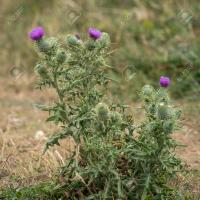Spear thistle
Cirsium vulgare
Cirsium vulgare, commonly known as bull thistle or spear thistle, is a biennial or sometimes perennial flowering plant in the Asteraceae family. Native to Europe and Asia, it has become naturalized in many parts of North America. Bull thistle is known for its distinctive spiny leaves and vibrant purple flowers. Here is an informative description of Cirsium vulgare, including its appearance, habitat, and management:
Description:
-
Growth Form: Bull thistle is a robust herbaceous plant that can grow up to 1.5 meters (5 feet) or more in height.
-
Leaves: The leaves are deeply lobed and armed with sharp, spiny projections along the margins. The upper surface of the leaves is dark green, while the lower surface is lighter and covered with fine hairs.
-
Stems: The stems are erect, ridged, and often covered with spines.
-
Flowers: The flowering heads are large and showy, with vibrant purple to pink disk florets surrounded by spiny bracts. The flowers are typically borne at the ends of the stems.
-
Roots: Bull thistle has a deep taproot, which aids in its ability to tolerate various soil conditions.
Habitat:
Bull thistle is adaptable to a wide range of habitats but is commonly found in disturbed areas, meadows, pastures, roadsides, and along the edges of fields. It can thrive in both dry and moist soils.
Identification:
Identifying Cirsium vulgare involves recognizing its key features:
-
Spiny Leaves: The deeply lobed leaves have sharp spines along the margins.
-
Large Flowering Heads: The flowering heads are large, with vibrant purple to pink disk florets and surrounded by spiny bracts.
-
Erect Stems: The stems are erect, ridged, and often covered with spines.
-
Taproot: Bull thistle typically has a deep taproot.
Management:
Bull thistle can be considered invasive in certain contexts, and its spines can pose challenges for grazing animals. Management strategies may include:
-
Mechanical Control: Mowing or cutting the plants before they produce seeds can help reduce the spread of bull thistle.
-
Herbicides: Selective herbicides may be used for targeted control, but care must be taken to avoid harm to desirable vegetation.
-
Grazing Management: Some livestock, such as goats, may feed on bull thistle, providing a form of biological control.
-
Prevention: Implementing preventive measures, such as maintaining healthy stands of desirable vegetation, can help reduce the establishment of bull thistle.










